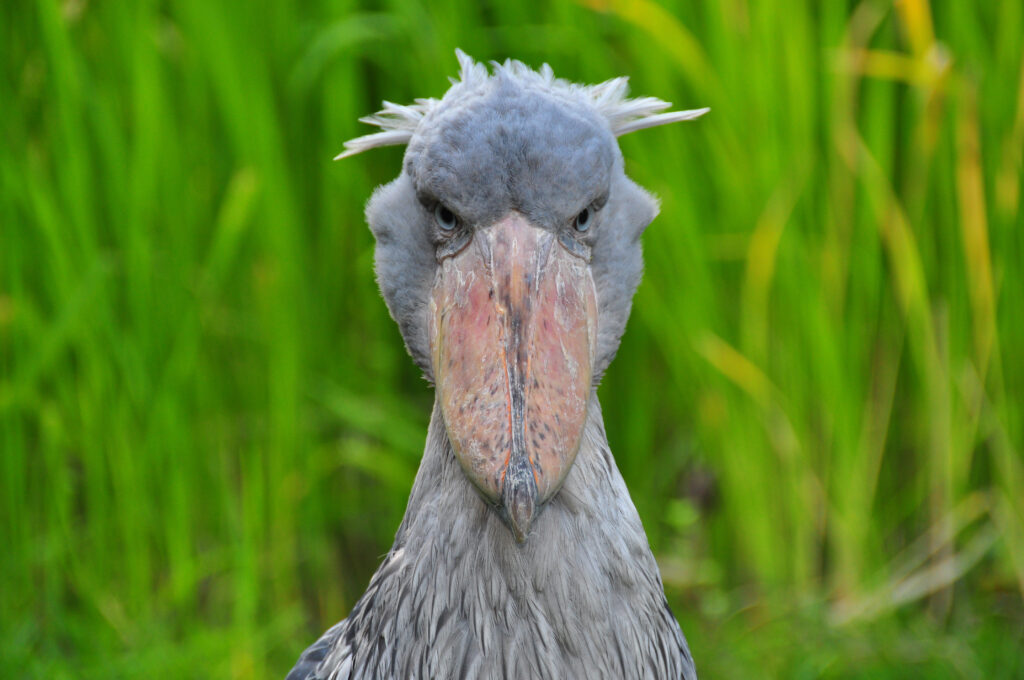Shoebill
Originally published on 2017/08/28. Click here to return to the OneWordBirds Archives.
Common names for species – that is, the names we use in regular conversation – are a tricky business. Take, for example, the name “sparrowhawk”. Many people in North America, where I happen to live, are familiar with sparrowhawks. Because I am a bird person, at least once per month a complete stranger tells me about a sparrowhawk that he saw, then waits for me to look suitably impressed. The problem? I have no idea what bird he’s talking about.
Here on my continent, the word “sparrowhawk” is a colloquial or traditional name for no fewer than three species. It is often used in reference to either of our two small, bird-hunting hawks: the Cooper’s Hawk and the Sharp-shinned Hawk. It is also used, perhaps even more frequently, for the American Kestrel which is, notably, not a hawk at all. This tiny falcon does, however, have a taste for sparrow-flesh, and so it gets stuck with this awkward moniker too.
Complicating matters even further is that in Europe and Asia there is a bird whose proper name is Eurasian Sparrowhawk. This would be alright except that British people invented birding and consider all of their birds to be the originals, so they drop the modifier and just call it Sparrowhawk. They do so ignoring the fact that it has about 20 close relatives throughout the Old World with names also ending in sparrowhawk (such as Chinese Sparrowhawk, Japanese Sparrowhawk, Madagascar Sparrowhawk and so on).
My point – and I do have one – is that common names can be confusing. Different people call birds different things in different places. Sometimes a bird has several different common names, and sometimes one common name refers to several different birds. It all depends who you ask, and that makes communicating about birds challenging.
This is why scientists like scientific (or binomial, or latin) names. These “official” names are governed by international codes, and are unique and unvarying. There may be more than 25 birds worldwide that are sometimes called sparrowhawk, but there’s only one Accipiter cooperii and one Falco sparverius, and that’s an end of it.
Except it isn’t, because it’s a pain in the ass to say “I just got in from a hike, and I saw two Accipiter cooperiis and three Falco sparveriuses.” Nobody talks like that. So we need common names for common parlance, but we also need to be able to communicate accurately about which species is which.
For this reason, the scientific community attempts to standardize common names, which usually means making them more boring. Bluebill becomes Lesser Scaup, Whiskeyjack becomes Gray Jay, Thunder-pumper becomes American Bittern and numerous other perfectly-descriptive and entertaining names are lost to the banality of scientific rigor.
All this is why it brings me almost inexplicable joy when a silly, colourful, one-word, common name refuses to go quietly. And now, at long last, let me introduce you to the bird behind my rambling introduction: the Shoebill. Not the African Gray Heron, not the Large-billed Stork or some other dull combination. Just the Shoebill, full stop.

Unlike some other one-word-birds, the Shoebill’s unique name requires no explanation. Its meaning should be as plain as the, um, nose on your face. The honkin’ schnoz on this incredible bird gives it the striking air of a comic book supervillian, complemented by a sinister glare and comical tuft of feathers atop its head. It almost begs you to laugh at it, if only so it can trigger a trap door and send you plummeting to a fiery death.
It may look utterly ridiculous, but this oversized snoot is the perfect tool for hunting fish and other aquatic vertebrates. The Shoebill spends much of its time standing completely motionless, like some strangely-proportioned statue, then lunges with lightning speed when it spots its prey. Lungfish are a favourite meal, and the Shoebill can use its gargantuan grabber to snatch up bigger prey than other wading birds.

The reason the enigmatic Shoebill has remained in the one-word-bird camp may have less to do with its physical uniqueness and more to do with its murky family situation. Taxonomists have never been quite sure what group to place the bird in, originally grouping it with the storks but more recently with the herons, and presently with the pelicans. At any rate its rather non-specific name allows for this taxonomic ambiguity, and so it sticks.
To observe this monster honker in all its resplendence, you’ll have to buy a ticket to eastern Africa. It would be money well-spent, for nothing else like the Shoebill exists in the entire world. If you do decide to journey to Kenya or Tanzania you’ll need to budget some time to learn their six-or-more sparrowhawks, but at least when some stranger starts yammering on about the Shoebill he saw that morning, you’ll know exactly what bird he’s talking about.
Photos:
Top: By Olaf Oliviero Riemer, CC BY-SA 3.0, https://commons.wikimedia.org/w/index.php?curid=18375332
Bottom & feature: By flowcomm – Shoebill (Balaeniceps rex), Uganda, CC BY 2.0, https://commons.wikimedia.org/w/index.php?curid=132683743

